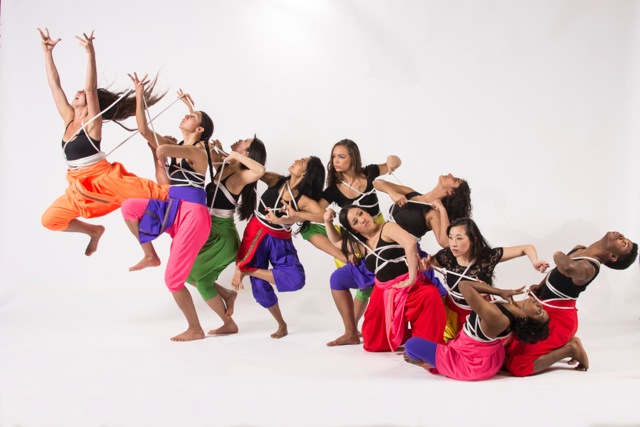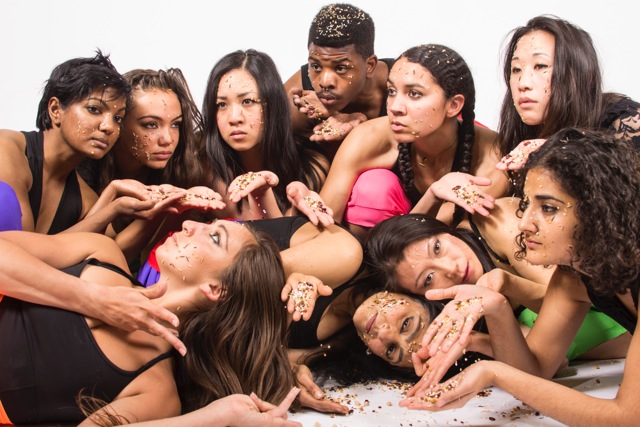
Women of color take center stage with Ananya Dance Theatre

Ananya Dance Company. Photo by V. Paul Virtucio.
To the layperson, the concept of studying for a dance performance probably suggests doing exercises in the studio, or maybe watching videos of one’s routines. For Ananya Dance Theatre, dance research is a little more involved than that. Composed mostly of women of color, the company’s work focuses specifically on social justice themes, and founder Ananya Chatterjea’s philosophy calls for an intimate understanding of the issues they explore.
“The creation of our work is rooted in extensive research and dialogue with our communities,” said Ananya Managing Director Gary Peterson. “Women from a variety of backgrounds are invited regularly to the studio to share their stories and to begin to express those stories in simple movement, story sharing and movement circles.” When the company performed at a benefit for an affordable housing organization this spring, for instance, dancers had conversations with homeless residents of the Twin Cities to develop a deeper knowledge of, in Peterson’s words, “individuals whose experiences of being unsafe could only be understood through deep imagination, cultivation of vulnerability, and resonance.”
That quest for understanding doesn’t end once a production is mounted. After premiering in September in St. Paul, the Knight-funded food- and agriculture-themed production “Roktim” was presented overseas to the National Theater in Ethiopia. The artists took the opportunity to educate themselves on the real-life experiences of some of the people depicted in and affected by their art. “The company’s travels provide flesh-and-blood perspective for the common issues that are addressed in their dances and experienced by women across the global landscape,” Peterson said. “In Ethiopia, the dancers conducted movement workshops at a safe house for women and children who had survived abuse, and witnessed first-hand how artistic practices can directly impact those living with traumatic memories.”

Ananya Dance Company. Photo by V. Paul Virtucio.
That kind of international outreach makes sense for Ananya, whose members claim ancestry from all around the world. Chatterjea identifies as Bengali, and her artistic philosophy is grounded in classical and contemporary Indian dance, along with yoga and martial arts. Each dancer is invited to bring her own identity to the performance, creating a complex portrait of women facing down some of our era’s most pressing social issues.
Still, Peterson said, the company’s underlying identity is uniquely Minnesotan. “Artistically, this company could not have been created outside of the Twin Cities and the communities of people who live and work here. Many cultural gatekeepers and audiences do not have a frame of reference for the combination of our movement vocabulary, our insistence on artistic excellence, our focus on women and social justice, and our composition of performers. It is really very American.”
It speaks to Ananya’s cross-cultural appeal that the politically-charged and satirical “Roktim” was welcomed as enthusiastically in Ethiopia as it was in its debut at Saint Catherine’s O’Shaughnessy Auditorium in September. It’s an ambitious production that takes place over two hours in multiple locations both indoors and out. Perhaps inevitably, that meant one of the Saint Paul performances was beset by rain.

Seitu Jones & Ananya Dance Theatre at Seitu Farms.
“The performers acknowledged the weather in their recitation at the top of the show,” said Peterson “‘We are with you, rain or shine!’ In act one, audience members were organized into several tour groups, each led by an actor portraying a tour guide of the Pronto FeedzAll food and seed laboratories. Audiences were encouraged to interact verbally with their tour guides, and many did so. Following acts two and three inside the theater, dancers and drummers led the audience back to the plaza to dance in the darkness and rain, lit by blazing torches and twinkle lights.”
That triumph over the elements perhaps works as a metaphor for Ananya’s dedication to overcoming obstacles and giving voice to people who are too often silenced or ignored. “ADT dances explore and reflect the grit of women’s lives and celebrate the resilience of the human spirit,” Peterson said. “People die a thousand deaths – psychological, spiritual, physical – in ADT’s performances, but they always, always rise again.”
Learn more about Ananya Dance Theatre’s history, philosophy and upcoming events at ananyadancetheatre.org.

Ananya Dance Theatre in the Crossing Boundaries opening ceremony, Ethiopian National Theatre.
Recent Content
-
Artsarticle ·
-
Artsarticle ·
-
Artsarticle ·

